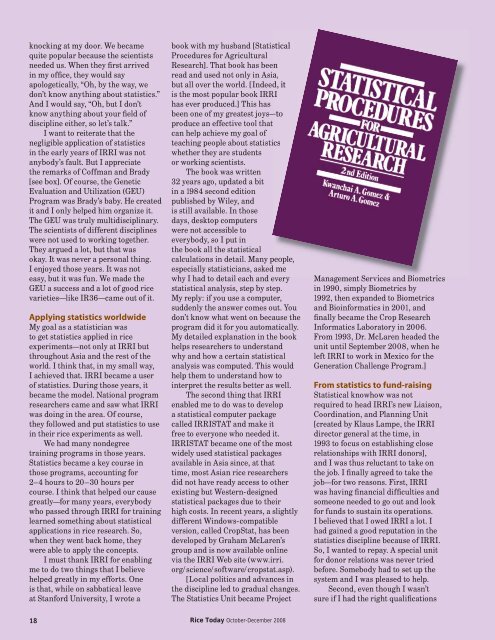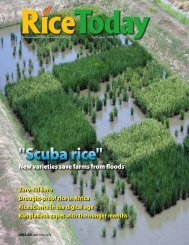Rice Today - adron.sr
Rice Today - adron.sr
Rice Today - adron.sr
Create successful ePaper yourself
Turn your PDF publications into a flip-book with our unique Google optimized e-Paper software.
knocking at my door. We becamequite popular because the scientistsneeded us. When they first arrivedin my office, they would sayapologetically, “Oh, by the way, wedon’t know anything about statistics.”And I would say, “Oh, but I don’tknow anything about your field ofdiscipline either, so let’s talk.”I want to reiterate that thenegligible application of statisticsin the early years of IRRI was notanybody’s fault. But I appreciatethe remarks of Coffman and Brady[see box]. Of course, the GeneticEvaluation and Utilization (GEU)Program was Brady’s baby. He createdit and I only helped him organize it.The GEU was truly multidisciplinary.The scientists of different disciplineswere not used to working together.They argued a lot, but that wasokay. It was never a personal thing.I enjoyed those years. It was noteasy, but it was fun. We made theGEU a success and a lot of good ricevarieties—like IR36—came out of it.Applying statistics worldwideMy goal as a statistician wasto get statistics applied in riceexperiments—not only at IRRI butthroughout Asia and the rest of theworld. I think that, in my small way,I achieved that. IRRI became a userof statistics. During those years, itbecame the model. National programresearchers came and saw what IRRIwas doing in the area. Of course,they followed and put statistics to usein their rice experiments as well.We had many nondegreetraining programs in those years.Statistics became a key course inthose programs, accounting for2–4 hours to 20–30 hours percourse. I think that helped our causegreatly—for many years, everybodywho passed through IRRI for traininglearned something about statisticalapplications in rice research. So,when they went back home, theywere able to apply the concepts.I must thank IRRI for enablingme to do two things that I believehelped greatly in my efforts. Oneis that, while on sabbatical leaveat Stanford University, I wrote abook with my husband [StatisticalProcedures for AgriculturalResearch]. That book has beenread and used not only in Asia,but all over the world. [Indeed, itis the most popular book IRRIhas ever produced.] This hasbeen one of my greatest joys—toproduce an effective tool thatcan help achieve my goal ofteaching people about statisticswhether they are studentsor working scientists.The book was written32 years ago, updated a bitin a 1984 second editionpublished by Wiley, andis still available. In thosedays, desktop computerswere not accessible toeverybody, so I put inthe book all the statisticalcalculations in detail. Many people,especially statisticians, asked mewhy I had to detail each and everystatistical analysis, step by step.My reply: if you use a computer,suddenly the answer comes out. Youdon’t know what went on because theprogram did it for you automatically.My detailed explanation in the bookhelps researchers to understandwhy and how a certain statisticalanalysis was computed. This wouldhelp them to understand how tointerpret the results better as well.The second thing that IRRIenabled me to do was to developa statistical computer packagecalled IRRISTAT and make itfree to everyone who needed it.IRRISTAT became one of the mostwidely used statistical packagesavailable in Asia since, at thattime, most Asian rice researchersdid not have ready access to otherexisting but Western-designedstatistical packages due to theirhigh costs. In recent years, a slightlydifferent Windows-compatibleversion, called CropStat, has beendeveloped by Graham McLaren’sgroup and is now available onlinevia the IRRI Web site (www.irri.org/science/software/cropstat.asp).[Local politics and advances inthe discipline led to gradual changes.The Statistics Unit became ProjectManagement Services and Biometricsin 1990, simply Biometrics by1992, then expanded to Biometricsand Bioinformatics in 2001, andfinally became the Crop ResearchInformatics Laboratory in 2006.From 1993, Dr. McLaren headed theunit until September 2008, when heleft IRRI to work in Mexico for theGeneration Challenge Program.]From statistics to fund-raisingStatistical knowhow was notrequired to head IRRI’s new Liaison,Coordination, and Planning Unit[created by Klaus Lampe, the IRRIdirector general at the time, in1993 to focus on establishing closerelationships with IRRI donors],and I was thus reluctant to take onthe job. I finally agreed to take thejob—for two reasons. First, IRRIwas having financial difficulties andsomeone needed to go out and lookfor funds to sustain its operations.I believed that I owed IRRI a lot. Ihad gained a good reputation in thestatistics discipline because of IRRI.So, I wanted to repay. A special unitfor donor relations was never triedbefore. Somebody had to set up thesystem and I was pleased to help.Second, even though I wasn’tsure if I had the right qualifications18<strong>Rice</strong> <strong>Today</strong> October-December 2008RT7-4 (p1-23)_FA.indd 1810/9/2008 8:24:36 AM
















